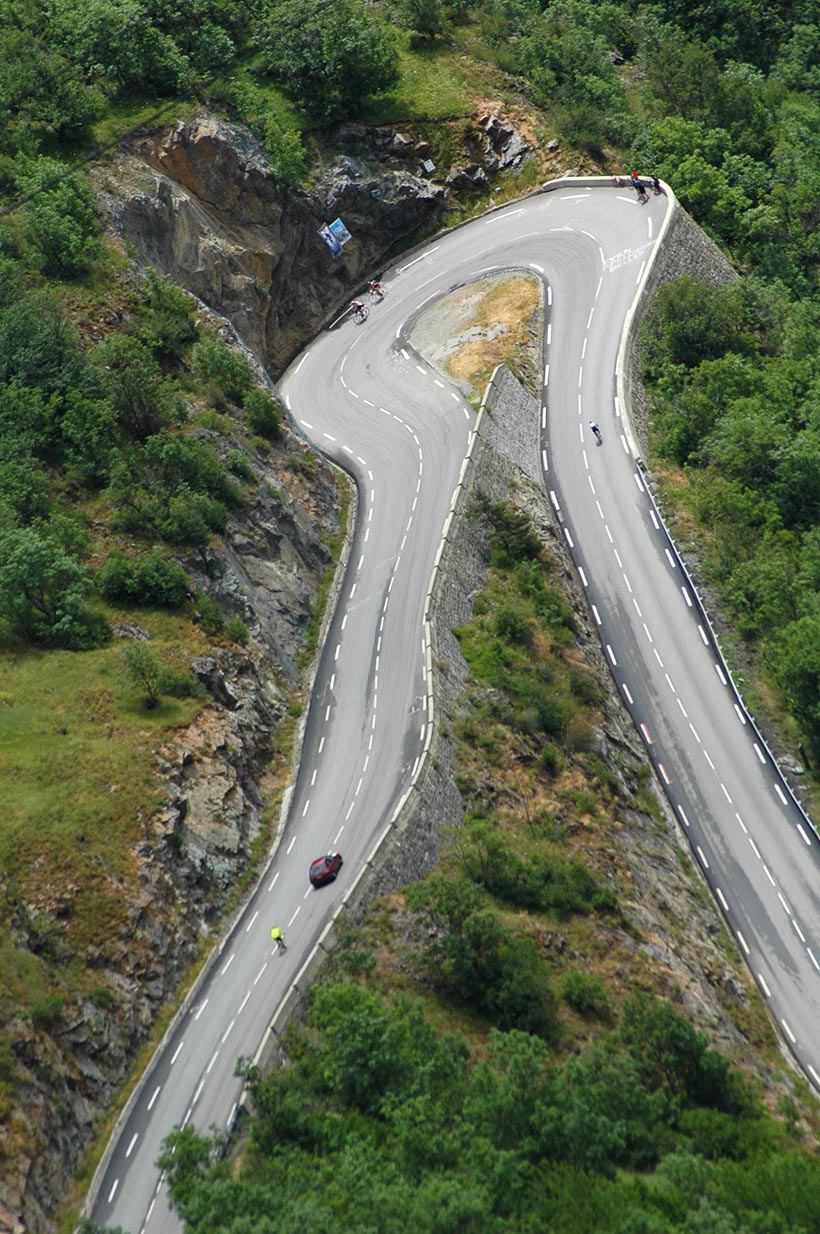Alpe d’Huez
The word ‘iconic or historic’ is often over-used in the world of cycling, but its application to this mountain is truly justified in every way.
Nicknamed the “Dutch Mountain”, the 13.9km stretch of tarmac snakes its way from Bourg d’Oisans in the Romanche valley to the mountain top ski resort of Alpe d’Huez (the first ski lift was constructed in 1935). It’s made up of relentless turns blended together with varying gradients. The mountain consists of 21 smoothly surfaced and cambered hairpins which has made this geographical area of the French Alps an iconic part of the Tour de France.
Although Alpe d’Huez is now a consistent fixture of the Tour de France, it wasn’t used in the race until 1952, providing the location of the Tour’s first ever summit finish. At first it wasn’t branded a huge success by the race organizer, but the battles won and lost on the slopes have created so many memorable moments in cycling history. Fausto Coppi rode a Bianchi steel frame bicycle and recorded a time of 45:22 in 1952, Pantani recorded the fastest ever time in 1997, 37:35.
The climb wasn’t used by the Tour again until 1976, when both the sport and the ski resort had been further developed and modernized.
The climb has become a ‘must do’ ascent for many cyclists, and is a mecca for bike-bound enthusiasts every year when the snow decides to melt away and expose the snake like charm of the mountain.
- FACTS & FIGURES
- THE HAIRPINS
-
Region: Isere, Northern Alps, France
Open: April to December
Access: From Grenoble (52km to the bottom, by vehicle), take the A480 motorway towards Sisteron, leave at exit number 8, follow the D1085 to Vizille and the D1091 to Le Bourg d’Oisans.
Height: 1,803m
Length: 13.9km
Altitude Gain: 1,073m
Average Gradient: 8.19%
Maximum Gradient: 12% (km 6.5)
Refreshments: Fountains in La Ferriere and Huez. Bars/Restaurants found in Le Bourg and at the summit of this iconic mountain.
-
Each one of the 21 hairpin bends are named after a Pro Tour Rider, some bends have been given two names.
List of Pro rider names which can be found on road signs at each hairpin bend:
Hairpin 21: 1952 Fausto Coppi, 2001 Lance Armstrong
Hairpin 20: 1976 Joop Zoetemelk, 2003 Iban Mayo
Hairpin 19: 1977 Hennie Kuiper, 2004 Lance Armstrong
Hairpin 18: 1978 Hennie Kuiper, 2006 Frank Schleck
Hairpin 17: 1979 Joachim Agostinho, 2008 Carlos Satre
Hairpin 16: 1979 Joop Zoetemelk, 2011 Pierre Rolland
Hairpin 15: 1981 Peter Winnen
Hairpin 14: 1983 Peter Winnen
Hairpin 12: 1984 Luis Herrera
Hairpin 11: 1984 Bernard Hinault
Hairpin 10: 1987 Federico Echave
Hairpin 09: 1988 Steven Rooks
Hairpin 08: 1989 Gert – Jan Theunisse
Hairpin 07: 1990 Gianni Bugno
Hairpin 06: 1991 Gianni Bugno
Hairpin 05: 1992 Andy Hampsten
Hairpin 04: 1994 Roberto Conti
Hairpin 03: 1995 Marco Pantani
Hairpin 02: 1997 Marco Pantani, Iban Mayo
Hairpin 01: 1999 Giuseppe Guerini
Looking at the list below its possible to see that, although Fausto Coppi rode his bike in a completely different generation to the rest of these champions he is still up there with the best in ascents of Alpe d’Huez. That is why he is the “champion of champions”.
Some of the top 10 names below have now been removed due to doping vialations.
In the all-time top 10 fastest rides on the legendary Alpe d’Huez, Coppi is still placed 28th overall fastest time!
1: 1997: 37:35 Marco Pantani
2: 2004: 37:36 Lance Armstrong
3: 1994: 38:00 Marco Pantani
4: 2001: 38:01 Lance Armstrong
5: 1995: 38:04 Marco Pantani
6: 1997: 38:23 Jan Ullrich
7: 2006: 38:34 Floyd Landis
8: 2006: 38:35 Andreas Kloden
9: 2004: 38:37 Jan Ullrich
10: 1997: 39:02 Richard Virenque
28: 1952: 45:22 Faust Coppi


